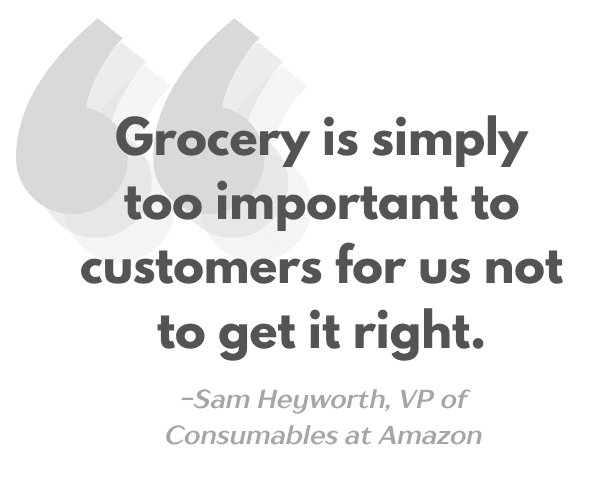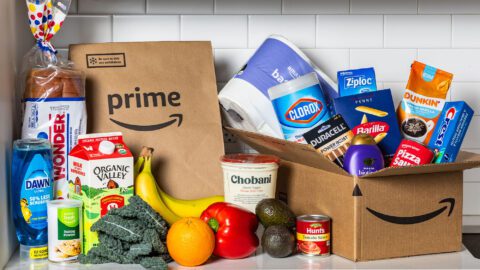This is the first story in a two-part series. The second installment continues here.
Amazon made its name as “The Everything Store,” and that has never been more true. But while Walmart is busy touting the unexpected variety on its marketplace, Amazon has already proven its point on that front and moved on — to toilet paper.
Not just toilet paper, of course, but all the indispensable quotidien items that fill our homes and facilitate modern life: batteries, pet food, face cream, diapers, cleaning spray. Amazon calls these products “Everyday Essentials,” and while they are certainly less captivating than saunas and dancing shoes, they are a big business — and becoming even bigger for Amazon in particular.

In fact, Everyday Essentials are quietly becoming the driving force of Amazon’s marketplace, now accounting for one out of every three products sold.
This is not purely a symptom of these anxious times, according to Sam Heyworth, Amazon’s VP of Consumables: “In the current economic environment, consumers are understandably more value-conscious, focusing their spending on necessities, and this naturally benefits Everyday Essentials as a category,” he said in an interview with Retail TouchPoints. “But the growth we’re seeing significantly outpaces the market — our Everyday Essentials business grew more than twice as fast as the rest of our U.S. [online] store in Q1 2025. That kind of differential comes from specific improvements we’ve made to the shopping experience.”
Those improvements are part and parcel of Amazon’s long-held ambition to become a leader in grocery. However, when the company’s efforts in that regard are viewed independently, it’s hard to point to one explicit sign of success. Whole Foods remains a strong brand, with an expanded footprint and sales up 40% through Amazon’s tenure, but anecdotally the topline sentiment among many customers is often one of relief that Amazon hasn’t transformed the beloved chain beyond recognition; Amazon Fresh, after a pause and a number of pivots, appears to be gaining steam, but the banner is far from dotting the countryside; and after a raft of closures, the Amazon Go convenience concept appears to no longer be a focus of growth, with the store count now whittled down to 16.
However, to view Amazon’s grocery business through each of its independent elements neglects the infamous Amazon flywheel. And when you step back and look at that grocery flywheel, the picture is very different. Here’s what it shows — even if you exclude sales from Whole Foods Market and Amazon Fresh, Amazon is already one of the largest grocers in the U.S., with over $100 billion in gross sales.
Everyday Essentials: The Fuel for Amazon’s Grocery Ambitions
Where does that $100 billion come from? Everyday Essentials on Amazon.com, for the most part. Those steady, sedate sales of non-perishable household necessities are not only the backbone of Amazon’s grocery business, but the essential fuel driving its larger ambitions, which very much include brick-and-mortar.
“Our ambition is simple: We want to make grocery shopping easier, faster and more affordable,” said Heyworth. “That might sound basic, but if you think about it, grocery shopping has become increasingly complicated over the past couple decades. The average consumer now visits four to five different retailers for groceries every month. There are more products competing for a place in your basket, more brands at more price points and more stores with overlapping selection.

“While choice is good, it comes at a cost — people now spend more time and mental energy figuring out what they need, where to get it and at what price,” Heyworth added. “What we’re trying to build is an experience where customers can get all their groceries and household goods in one place, at competitive prices, through whatever shopping method works best for them. Whether that’s through Amazon.com with free Prime shipping; grocery delivery or pickup from Whole Foods Market, Amazon Fresh or our third-party partners; or shopping in our stores, we want to offer the array of choices customers need for all their shopping trips.”
But making that kind of flexibility possible for Amazon customers has taken years of trial and development. Heyworth took us inside Amazon’s grocery flywheel to help us understand how all the ingredients the company now has at its disposal — including delivery speed, channel integration, inventory optimization, subscriptions and membership — are combining to create a recipe for success.
But First, Why Does the Grocery Category Matter so Much?
It’s important to understand why Amazon, which already dominates so many other categories and corners of our lives, is so bent on succeeding in grocery. The answer is simple: it’s the most essential kind of shopping we do — and once a company is planted into your routine, it can be hard to uproot.
“Grocery is simply too important to customers for us not to get it right,” said Heyworth. “It’s one of the largest categories in terms of household spend, with the highest purchase frequency and one of the deepest relationships when it comes to retail and shopping. Our experimentation in grocery over the years has been intentional, validating our thinking in this space, and as a result, two principles remain true today: One, customers want seamless shopping across stores and brands, and to decide what’s most convenient; and two, value is king, particularly on high-quality products.”
Grocery is a must-win category for Amazon, and the company is getting closer to that goal than may be immediately evident.
Continue reading the second installment of this two-part series, to learn about the evolutions that are now helping Amazon deliver on those two tenets of grocery retail across all its channels.















